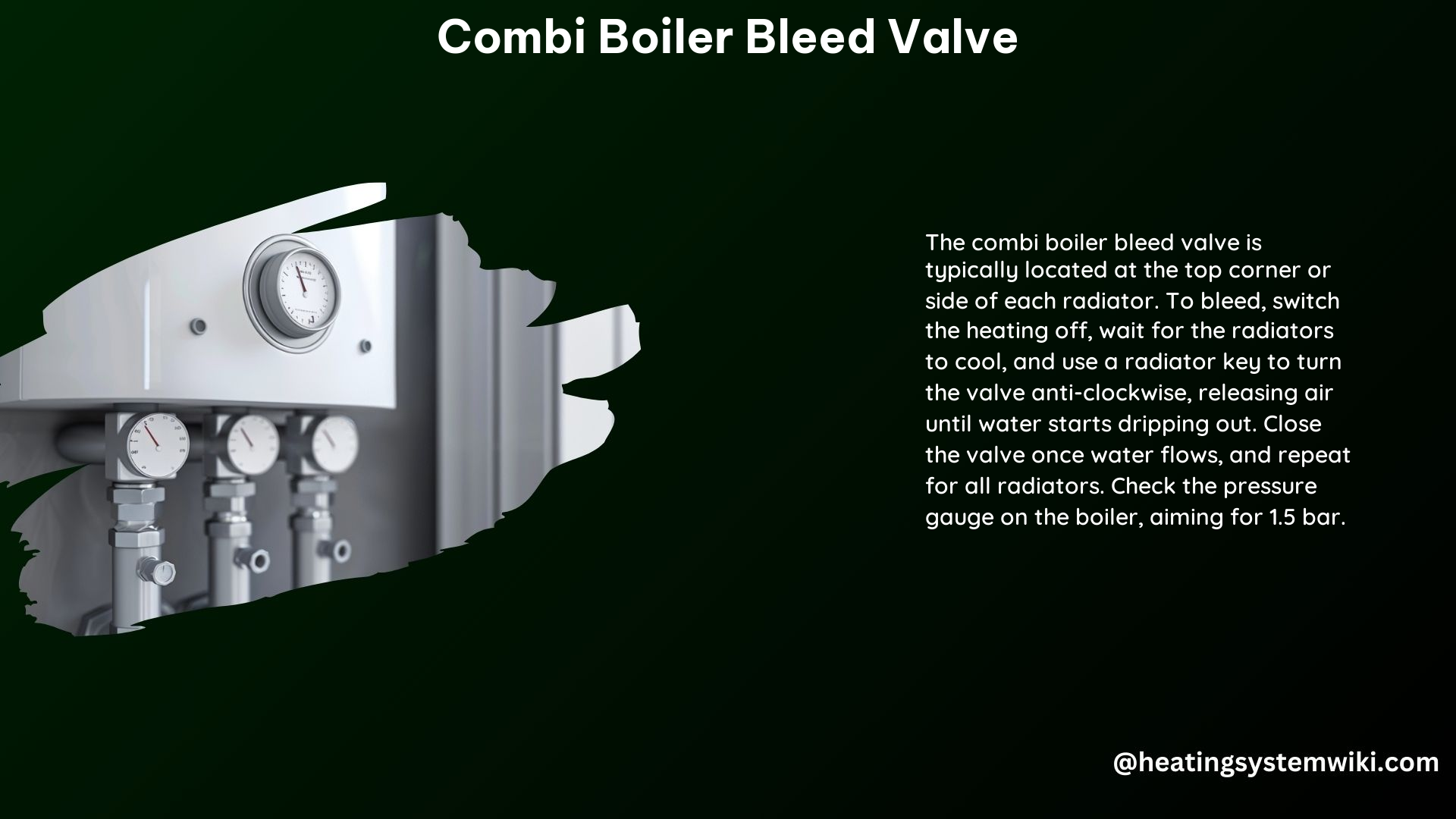The combi boiler bleed valve is a crucial component in maintaining the efficiency and performance of a combi boiler heating system. This comprehensive guide will provide you with a deep understanding of the technical specifications, purpose, and step-by-step instructions for properly bleeding your combi boiler radiators.
Location of the Combi Boiler Bleed Valve
The combi boiler bleed valve is typically located at the top corner or side of each radiator in the heating system. The exact position may vary depending on the manufacturer and model of the radiator. In most cases, the bleed valve is accessible with a standard radiator bleed key or a flathead screwdriver, making it easy for homeowners to perform the bleeding process.
Purpose of Bleeding a Combi Boiler Radiator

Bleeding a combi boiler radiator is essential to remove trapped air bubbles that can accumulate within the heating system. These air pockets can cause several issues, including:
- Uneven Heating: Air bubbles can prevent the even distribution of heat throughout the radiator, leading to some areas being warmer than others.
- Strange Noises: The presence of air in the system can create gurgling or banging sounds, which can be both annoying and indicative of a problem.
- Reduced Efficiency: Air bubbles reduce the overall efficiency of the heating system, leading to higher energy consumption and increased heating costs.
By bleeding the radiators, you can ensure that the system is fully filled with water, allowing for proper heat transfer and optimal system performance.
Technical Specification of Combi Boiler Bleed Valve
The combi boiler bleed valve is designed to serve a specific purpose within the heating system. Here are the key technical specifications:
- Valve Type: The bleed valve is typically a quarter-turn valve, meaning it can be opened and closed by turning it a quarter rotation (90 degrees) in the appropriate direction.
- Valve Material: Combi boiler bleed valves are commonly made of brass or stainless steel, which are durable and corrosion-resistant materials.
- Valve Size: The standard size for combi boiler bleed valves is 1/2 inch (12.7 mm) in diameter, although some may be slightly larger or smaller depending on the radiator and system requirements.
- Valve Operation: The bleed valve is opened by turning it anti-clockwise, which allows air to escape from the radiator. Once the air has been released, the valve is closed by turning it clockwise to prevent water leaks.
- Valve Pressure Rating: Combi boiler bleed valves are typically rated to withstand a maximum system pressure of 3 bar (43.5 psi), ensuring they can safely operate within the normal pressure range of a combi boiler heating system.
Step-by-Step Guide to Bleeding a Combi Boiler Radiator
Bleeding a combi boiler radiator is a straightforward process that can be easily performed by homeowners. Follow these steps to ensure a successful and safe bleeding procedure:
-
Turn Off the Heating System: Before starting the bleeding process, ensure that the combi boiler and radiators are cool to the touch. This will prevent any risk of scalding from hot water or steam.
-
Locate the Bleed Valve: Identify the bleed valve, which is typically located at the top corner or side of the radiator. The valve may be accessible with a radiator bleed key or a flathead screwdriver, depending on the design.
-
Prepare the Necessary Tools: Gather the following items:
- Radiator bleed key or flathead screwdriver
- Cloth or old rags to catch any water drips
-
A small container to collect any water that may come out during the bleeding process
-
Open the Bleed Valve: Insert the bleed key or screwdriver into the bleed valve and turn it anti-clockwise. You may hear a hissing sound as the air escapes from the radiator.
-
Close the Bleed Valve: Once you see water start to drip from the valve, turn the valve clockwise to close it securely. This will prevent any water leaks.
-
Repeat for All Radiators: Proceed to bleed all the radiators in the heating system, starting with the one furthest from the combi boiler and working your way towards the boiler.
-
Check the System Pressure: After bleeding all the radiators, check the pressure gauge on the combi boiler. The pressure should be within the recommended range, typically between 1 and 1.5 bar. If the pressure is too low, you may need to top up the system with water.
Additional Tips for Combi Boiler Bleed Valve Maintenance
- Regular Checks: Regularly inspect your radiators for any signs of air buildup, such as cool spots or strange noises. This will help you identify the need for bleeding before the system’s efficiency is significantly impacted.
- Insulated Gloves: When bleeding radiators, use insulated gloves to protect your hands from the hot water and steam that may be released.
- Consult a Professional: If you are unsure about the bleeding process or encounter any issues, it is recommended to consult a qualified heating engineer for assistance.
Conclusion
The combi boiler bleed valve is a crucial component in maintaining the efficiency and performance of your combi boiler heating system. By understanding the technical specifications, purpose, and proper bleeding procedure, you can ensure your heating system operates at its best, providing you with a comfortable and energy-efficient home environment.
References
- Mayne Gas Heating. (2020, October 7). How to bleed radiators with a combi boiler. Retrieved from https://www.maynegasheating.co.uk/how-to-bleed-radiators-with-a-combi-boiler
- Platinum Plumbers. (2023, January 9). How to bleed radiators on a combi boiler. Retrieved from https://platinumplumbers.org.uk/blog/bleed-radiators-combi-boiler
- Plumbnation. (2022, November 17). How to bleed radiators with a combi boiler. Retrieved from https://www.plumbnation.co.uk/blog/how-to-bleed-radiators-with-a-combi-boiler
